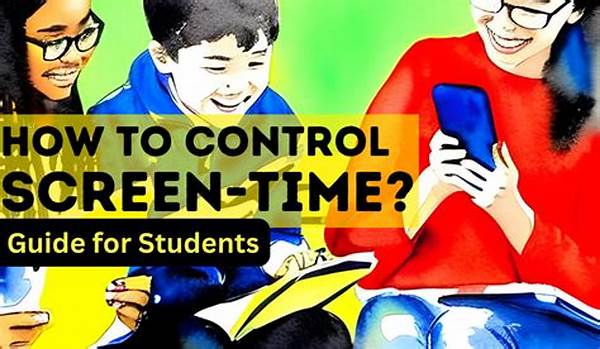How to Control Screen Time Effectively
In today’s digital era, managing screen time has become a crucial challenge. Whether it’s for work, education, or entertainment, screens dominate much of our daily lives. But does the excessive time spent in front of screens benefit us? Apparently, research suggests otherwise. Prolonged screen use is linked to eye strain, sleep disturbances, and even reduced productivity. The ultimate goal of learning how to control screen time effectively is to enhance the quality of life by improving our physical and mental well-being. With increased focus, better sleep, and a healthier lifestyle, the benefits of managing screen time are certainly enticing.
Read More : Digital Declutter Checklist Pdf
First and foremost, awareness is the key. Acknowledging the amount of time we spend on screens is the initial step toward controlling it. Implement applications or trackers that monitor your usage. Like a fitness tracker does for steps, a screen time tracker highlights areas for improvement. Ready for some humor? Imagine your tracker sarcastically reminding you, “Get a life!” every time you exceed a certain limit—it just might work!
Engage in alternative activities that bring you joy and stimulate your brain in different ways. This not only includes picking up a book but can involve joining a local club, learning an instrument, or simply going for a walk (Instagram can wait). When you mindfully replace screen time with productive hobbies, you’re in for an upgrade—a premium version of life without any extra cost!
Strategies to Manage Screen Time
Start small but think big. Set specific goals, such as reducing screen time by 15% each week. It’s like having a savings plan but instead of dollars, you save hours from your digital life bank. Following these strategies on how to control screen time effectively can pave the way to a balanced lifestyle, setting an example for peers, friends, and especially the younger generation.
—
Taking Control of Screen Time
When it comes to the balancing act between real-life fun and digital duties, it often feels like handling a circus! The skills of how to control screen time effectively are not just a necessity in our gadget-packed routines but a survival toolkit for thriving amidst the i-Daily life. Experts share that the average person spends over 7 hours each day staring at a screen. Can you imagine? That’s practically couch surfing the internet!
Why We Need to Limit Screen Time
Digging deeper into the rationale behind limiting screen time, it’s crucial to reflect on its impact on mental health. The rise in anxiety and depression, especially among teenagers, often correlates with the virtual companionship offered by gadgets. Research narratives hint that reducing screen time can lead to heightened real-world social interactions. Turning off the television and engaging in face-to-face conversations cultivates emotional bonds, fosters empathy, and just makes hangouts more genuine!
Implementing Changes to Screen Time
To make the shift from screens to scenes, consider implementing structured daily routines. Set up a “no screens” time in your household where everyone gathers for a meal or a board game. Imagine the testimonies shared by families who recovered traditional fun while embracing less screen exposure. Action-loving couch potatoes, be prepared! Your digital detox awaits.
Finally, as challenging as it sounds, remember to model the change. If you’re the kind of person who keeps telling others to “get off that phone,” it’s high time you practice what you preach. Embody the change, lessen zone-out moments, and take control of your gadget life assertively. Through these genuine steps, your narrative of how to control screen time effectively turns into a much sought-after big news, a breaking story of sorts!
—
Key Points to Control Screen Time
Learning how to control screen time effectively can revolutionize your health, be it physical or mental. It’s about rediscovering life’s authentic pleasures beyond the digital blur. Families regain mealtimes, friends rekindle conversations, and individuals connect with their passions. It’s not merely tips and tricks, but a rejuvenating journey towards self-fulfillment.
—
Successful Screen Time Management
Screen time management is akin to sophisticated artwork; start with an unprimed canvas, which in this case is your daily schedule. Swift brush strokes—whether they are setting screen-free times or incorporating engaging alternatives—work wonders in developing a masterpiece of balance and health. The art, nonetheless, lies in adhering to practices sustainably.
Building Meaningful Screen Habits
Rising above sheer statistics, it’s predicted that enhancing the quality of your screen interactions outweighs the quantity. What if all the hours spent online were swapped with enlightening TED talks, online courses, or podcasts? These constructive choices don’t just limit time; they transform it too!
The ownership of determining how to control screen time effectively is empowering—it’s a testimony of one’s capacity for a mindful existence amid a 24/7 plugged-in world. Whether you’re a corporate executive wanting to reclaim personal time or a tech-savvy teenager seeking balance, the responsibility of sculpting your digital habits rests in your capable hands.
And while humor may tint your journey with colors of light-heartedness, the core intent remains motivation, mapped by discipline and enthusiasm. As you navigate screen landscapes consciously, remember: How you choose today defines your tomorrow. So, take the leap, disconnect, and engage. After all, life lived through authentic pauses holds its charm untold.
—
9 Explanations on How to Control Screen Time Effectively
Desiring to learn how to control screen time effectively is not just about restrictions; it’s an exploration of all the joyous alternatives that life has to offer. From team sports to cooking experiments, the canvas of life brims with experiences waiting to be captured beyond screens. Remember, finding harmony is as scientific as it is artistic!
Embrace the melancholic parting with constant digital access for the melodious harmony of silent companionship with oneself and the world. The path toward moderated screen habits is filled with social experiments, varied adjustments, and eventually, peaceful cohabitation with technology. It’s a story where screens serve us, not enslave. Keep redefining your screen boundaries, and let the tale of moderation commence!


